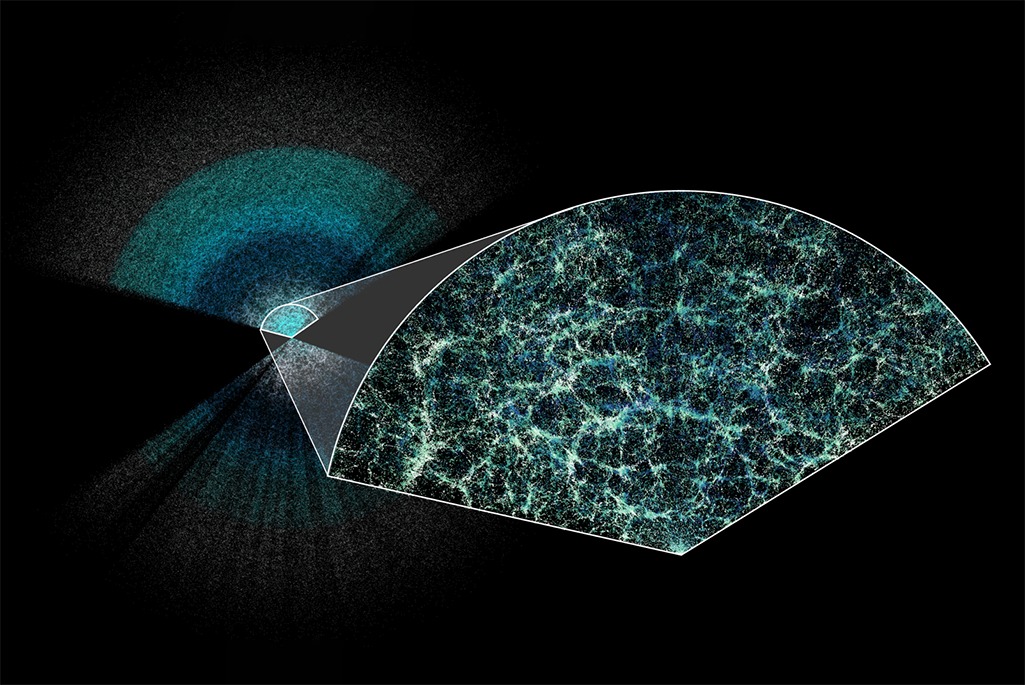
This press release was originally published by the U.S. Department of Energy’s Lawrence Berkeley National Laboratory.
DESI has made the largest 3D map of our universe to date. Earth is at the center of this thin slice of the full map. In the magnified section, it is easy to see the underlying structure of matter in our universe. Claire Lamman/DESI collaboration; custom colormap package by cmastro
Key Takeaways
- DESI mapped galaxies and quasars with unprecedented detail, creating the largest 3D map of the universe ever made and measuring how fast the universe expanded over 11 billion years.
- This is the first time that scientists have measured the expansion history of that distant period (8-11 billion years ago) with a precision of better than 1%, providing a powerful way to study dark energy.
- With just its first year of data, DESI has surpassed all previous 3D spectroscopic maps combined and confirmed the basics of our best model of the universe – with some tantalizing areas to explore with more data.
With 5,000 tiny robots in a mountaintop telescope, researchers can look 11 billion years into the past. The light from far-flung objects in space is just now reaching the Dark Energy Spectroscopic Instrument (DESI), enabling us to map our cosmos as it was in its youth and trace its growth to what we see today. Understanding how our universe has evolved is tied to how it ends, and to one of the biggest mysteries in physics: dark energy, the unknown ingredient causing our universe to expand faster and faster.
To study dark energy’s effects over the past 11 billion years, DESI has created the largest 3D map of our cosmos ever constructed, with the most precise measurements to date. This is the first time scientists have measured the expansion history of the young universe with a precision better than 1%, giving us our best view yet of how the universe evolved. Researchers shared the analysis of their first year of collected data in multiple papers that will be posted today on the arXiv and in talks at the American Physical Society meeting in the United States and the Rencontres de Moriond in Italy.
In this 360-degree video, take an interactive flight through millions of galaxies mapped using coordinate data from DESI. (Credit: Fiske Planetarium, CU Boulder and DESI collaboration)

“We’re incredibly proud of the data, which have produced world-leading cosmology results and are the first to come out of the new generation of dark energy experiments,” said Michael Levi, DESI director and a scientist at the Department of Energy’s Lawrence Berkeley National Laboratory (Berkeley Lab), which manages the project. “So far, we’re seeing basic agreement with our best model of the universe, but we’re also seeing some potentially interesting differences that could indicate that dark energy is evolving with time. Those may or may not go away with more data, so we’re excited to start analyzing our three-year dataset soon.”
Our leading model of the universe is known as Lambda CDM. It includes both a weakly interacting type of matter (cold dark matter, or CDM) and dark energy (Lambda). Both matter and dark energy shape how the universe expands – but in opposing ways. Matter and dark matter slow the expansion down, while dark energy speeds it up. The amount of each influences how our universe evolves. This model does a good job of describing results from previous experiments and how the universe looks throughout time.
However, when DESI’s first-year results are combined with data from other studies, there are some subtle differences with what Lambda CDM would predict. As DESI gathers more information during its five-year survey, these early results will become more precise, shedding light on whether the data are pointing to different explanations for the results we observe or the need to update our model. More data will also improve DESI’s other early results, which weigh in on the Hubble constant (a measure of how fast the universe is expanding today) and the mass of particles called neutrinos.
Read the complete news release By Lauren Biron
